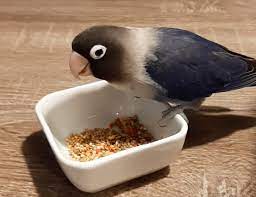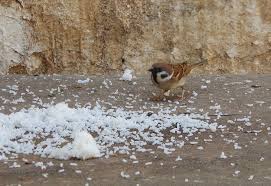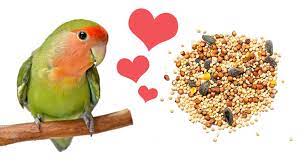Discover the perfect diet for your beloved Lovebirds! Our comprehensive guide on What Do You Feed Lovebirds provides essential tips .
Introduction
Welcome to the world of lovebirds, delightful and affectionate parrots known for their vibrant plumage and endearing personalities. In this comprehensive guide, we’ll explore the intricacies of lovebird care, focusing primarily on their dietary needs. Lovebirds, like any other pet, require a balanced and well-thought-out diet to thrive and lead a healthy life.
Overview of Lovebirds
Lovebirds, scientifically classified as Aquaporins, are small parrots originating from the African continent. These birds earned their charming name from their strong monogamous bond with their mates, a characteristic that has made them popular pets. They come in various species and color variations, each with its unique charm. Lovebirds are cherished for their playful and affectionate nature, making them ideal companions for bird enthusiasts.
The Importance of Proper Nutrition for Lovebirds
Proper nutrition is the cornerstone of a lovebird’s well-being. Like all parrots, they have specific dietary requirements to maintain their health, vitality, and longevity. A well-balanced diet ensures that they have the energy and nutrients they need for their playful antics and joyful chirps.
Purpose of the Article
The purpose of this article is to provide you with a comprehensive understanding of what to feed lovebirds, how to create a balanced diet, and the dos and don’ts of their nutrition. We will delve into the various aspects of their diet, from the natural foods they consume in the wild to the options available for pet lovebirds. By the end of this guide, you’ll be well-equipped to ensure the health and happiness of your feathered friends through a well-planned diet.
Lovebird Diet Basics

In the realm of lovebird care, understanding the basics of their diet is paramount. Lovebirds, like all parrots, have specific dietary requirements that play a vital role in their overall well-being. This chapter will explore the fundamental elements of what constitutes a healthy lovebird diet, providing you with the knowledge to ensure that your feathered friends receive the nutrition they need.
Natural Diet of Lovebirds
In the wild, lovebirds have access to a diverse range of foods. Their natural diet primarily consists of seeds, fruits, berries, and various vegetation. Understanding what they consume in their native habitats can offer valuable insights into their dietary needs as pets.
Understanding Lovebird Dietary Needs
Lovebirds require a diet that is rich in a variety of nutrients to stay healthy. Their nutritional needs include proteins, carbohydrates, fats, vitamins, and minerals. Providing them with a balanced diet ensures they receive all the essential elements required for their growth, energy, and overall health.
The Role of Seeds in Lovebird Diet
Seeds are a staple in a lovebird’s diet. However, it’s essential to choose the right mix of seeds to ensure they receive a balanced nutrition. Some seeds can be high in fat, so it’s crucial to monitor the type and quantity of seeds you offer to prevent overindulgence.
The Significance of Fruits and Vegetables
Fruits and vegetables play a crucial role in enhancing the dietary diversity of lovebirds. They provide essential vitamins, minerals, and fiber. Offering a colorful assortment of fresh produce can not only meet their nutritional requirements but also keep mealtime exciting.
The Dangers of High-Fat Foods
While lovebirds need some fats in their diet, an excess of high-fat foods can lead to obesity and other health issues. This section will shed light on the potential risks associated with feeding your lovebirds foods that are too rich in fats.
As we navigate through the lovebird’s dietary essentials, it’s essential to consider their unique requirements, which vary from those of other parrot species. By the end of this chapter, you’ll have a comprehensive understanding of the lovebird’s dietary basics, equipping you to make informed decisions about their nutrition.
Feeding Lovebirds: Best Practices
When it comes to nourishing your beloved lovebirds, adopting best practices is essential to ensure they receive a balanced and nutritious diet. This chapter delves into the finer details of providing the best possible nutrition for your feathered companions.
Creating a Balanced Diet
Achieving a well-balanced diet for your lovebirds involves careful planning and consideration. It’s not just about providing them with food; it’s about ensuring they get the right combination of nutrients to support their health and vitality. Here are some best practices for creating a balanced diet:
- Variety: Offer a variety of foods to ensure your lovebirds receive a wide range of nutrients.
- Proteins: Include sources of protein in their diet, such as legumes, lentils, and lean meats.
- Carbohydrates: Incorporate carbohydrates from grains and cereals.
- Fats: Provide healthy fats in moderation, such as those found in seeds and nuts.
- Vitamins and Minerals: Offer a selection of fruits and vegetables to cover their vitamin and mineral needs.
Safe Fruits for Lovebirds
While lovebirds can enjoy a variety of fruits, it’s important to be aware of which fruits are safe for them. Some fruits may contain harmful substances or high levels of natural sugars that can be detrimental to their health. Here’s a list of safe fruits to include in their diet:
Remember to remove any seeds, pits, or inedible parts from the fruits to prevent choking or ingestion of harmful compounds.
Recommended Vegetables for Lovebirds
Vegetables are another essential component of a lovebird’s diet. They provide vital vitamins and minerals, along with dietary fiber. Here are some recommended vegetables to consider:
- Carrots
- Broccoli
- Spinach
- Kale
- Bell peppers
- Zucchini
- Cucumber
Ensure that the vegetables are fresh and thoroughly washed to remove any pesticides or contaminants.
Nuts and Seeds: Do’s and Don’ts
Nuts and seeds can be a healthy addition to your lovebird’s diet when given in moderation. However, it’s crucial to be aware of the do’s and don’ts regarding these treats:
Do’s:
- Offer a variety of seeds, such as sunflower, safflower, and flax seeds.
- Provide unsalted nuts like almonds, walnuts, and pistachios as occasional treats.
Don’ts:
- Avoid feeding high-fat seeds excessively.
- Never offer salted or flavored nuts, as these can be harmful.
Pellets as a Supplementary Option
Pellets are commercially available as a convenient way to ensure your lovebirds receive a balanced diet. They are formulated to contain essential nutrients and can be a valuable addition to their food. However, pellets should not be the sole source of nutrition. It’s best to use them as a supplementary option alongside a variety of fresh foods.
By adopting these best practices, you can provide your lovebirds with the optimum nutrition they need to lead a healthy and joyful life.
Lovebird Feeding Schedule
A well-structured feeding schedule is a crucial aspect of providing the best care for your lovebirds. Establishing a consistent routine for their meals ensures that they receive the nutrition they need at the right times. In this chapter, we’ll explore the elements of a lovebird feeding schedule and its significance.
Frequency and Timing of Meals
Lovebirds thrive on a regular feeding schedule. Here’s a breakdown of the frequency and timing of their meals:
- Daily Meals: Lovebirds should receive two main meals each day, one in the morning and one in the evening. This routine mimics their natural foraging patterns.
- Morning Meal: Offer their first meal shortly after they wake up. This is when they are most active and ready to eat.
- Evening Meal: The second meal should be provided in the early evening. This timing allows them to digest their food before resting for the night.
Portion Control
Controlling portion sizes is vital to prevent overfeeding or underfeeding. Lovebirds have small stomachs, so it’s essential to provide the right amount of food for their size and activity level. Here are some guidelines for portion control:
- Seed Mix: For seed-based diets, offer a tablespoon of seed mix per bird during each meal.
- Pellets: When using pellets, follow the manufacturer’s recommendations for portion sizes based on your lovebird’s size.
- Fresh Foods: Fruits and vegetables should make up a small portion of their meals, typically about a teaspoon of each.
It’s crucial to observe your lovebirds and adjust portion sizes if you notice weight changes or changes in their appetite.
Fresh Water Requirement

A consistent supply of fresh, clean water is just as critical as their food. Lovebirds should have access to clean water at all times. Be sure to:
- Change Water Daily: Replace their water dish with fresh water daily to prevent contamination.
- Use a Clean Container: Use a clean container specifically for water to avoid cross-contamination with their food.
- Water Quality: Ensure the water is of good quality, free from impurities and contaminants.
By maintaining a regular feeding schedule and providing them with the appropriate portions of food and fresh water, you can promote the health and well-being of your lovebirds. A consistent routine also helps them feel secure and content in their environment.
Special Considerations
Feeding lovebirds is not a one-size-fits-all endeavor. As these charming birds progress through various life stages, their dietary needs and considerations change. This chapter explores special considerations for feeding lovebirds in different circumstances.
Feeding Baby Lovebirds
When you have the joy of raising baby lovebirds, providing them with the right nourishment is of utmost importance. Here’s what you need to know:
- Formula Feeding: Baby lovebirds require a specialized hand-feeding formula, which is available at pet stores or from avian veterinarians. This formula mimics the nutrition provided by their parents.
- Frequency: In the early stages, feed them every 2-3 hours. As they grow, you can reduce the frequency to 4-6 feedings per day.
- Temperature: Ensure that the formula is at the right temperature, around 105°F (40°C).
- Gradual Transition: As they grow, you can gradually introduce solid foods, such as softened pellets or finely chopped fruits and vegetables.
Health-Boosting Foods
Lovebirds, like all creatures, can benefit from certain foods that boost their overall health. Consider incorporating these health-enhancing options into their diet:
- Herbs: Fresh herbs like parsley and basil can provide added vitamins and minerals.
- Sprouted Seeds: Sprouted seeds are rich in enzymes and can aid in digestion.
- Chia Seeds: These tiny powerhouses are packed with omega-3 fatty acids.
- Dandelion Greens: Dandelion greens are a natural source of calcium and can help maintain their bone health.
Dietary Adjustments for Aging Lovebirds
As lovebirds age, their dietary requirements may change. Here’s how to cater to the needs of your senior feathered friend:

- Lower-Fat Diet: Older lovebirds tend to be less active, so consider reducing their fat intake. Limit high-fat seeds and nuts.
- Softened Foods: Aging birds might have difficulty with harder foods. Offer softer options, like cooked grains or steamed vegetables.
- Supplements: Consult with an avian veterinarian about potential supplements to support joint health and overall well-being.
Remember that individual lovebirds may have unique requirements, so it’s always a good idea to consult with a knowledgeable avian veterinarian for personalized guidance when it comes to special dietary considerations. By adapting their diet to their life stage, you can help ensure a long and healthy life for your cherished lovebirds.
FAQs
In the world of lovebird care, questions often arise about their dietary needs. In this chapter, we’ll address some of the most frequently asked questions regarding what to feed these delightful birds.
What Food Is Best for Lovebirds?
Opinions on the best food for lovebirds can vary among bird enthusiasts, but there are some consistent favorites. Lovebirds thrive on a balanced diet that includes a mix of seeds, fresh fruits, and vegetables. High-quality pellets can also be a valuable addition. The key is variety – offering a wide range of foods to ensure they receive a broad spectrum of nutrients.
Can Love Birds Eat Rice?
Yes, lovebirds can safely consume cooked rice. However, it’s essential to ensure that the rice is thoroughly cooked and served plain, without any seasonings or additives. Rice is a good source of carbohydrates and can be a part of their diverse diet, offering an alternative to their typical seed-based nutrition.
What Food Can Lovebirds Not Eat?
While lovebirds have a fairly versatile diet, some foods are best avoided to ensure their well-being. These include:
- Avocado: The flesh and pit of avocados contain a toxin called persin, which can be harmful to birds.
- Chocolate: Chocolate contains theobromine, which is toxic to birds.
- Alcohol: Alcohol can have severe effects on their small bodies and should never be given to lovebirds.
- High-Fat, Salty, or Sugary Foods: These can lead to health issues, including obesity and heart problems.
What Do You Feed a Baby Lovebird?
Feeding a baby lovebird requires specific knowledge and care. Baby lovebirds are typically fed a specialized hand-feeding formula, which should be warmed to the right temperature. Feeding is done via a syringe or a spoon, with the aim of replicating the care provided by their parents. As they grow, you can gradually introduce softened pellets and finely chopped fruits and vegetables into their diet.
What Foods Can Lovebirds Not Eat?
Lovebirds can be sensitive to certain foods, so it’s crucial to be aware of items that may be harmful. In addition to the foods mentioned in the “What Food Can Lovebirds Not Eat?” section, some lovebirds may have individual sensitivities or allergies, so it’s essential to monitor their reactions to new foods carefully.
As a lovebird owner, staying informed about their dietary needs and preferences is essential for their well-being. While they can enjoy a wide range of foods, it’s crucial to be mindful of their safety and health when introducing new items into their diet.
Conclusion
As we near the end of this informative journey on what to feed lovebirds, it’s time to summarize the key points and emphasize the vital role of proper nutrition in ensuring the health and happiness of these charismatic avian companions.
Recap of Lovebird Dietary Guidelines
Throughout this article, we’ve explored the lovebird’s dietary needs and best practices for feeding them. Here’s a quick recap of the essential guidelines:
- Variety is Key: Lovebirds thrive on a diverse diet that includes seeds, fruits, vegetables, and high-quality pellets.
- Portion Control: Be mindful of portion sizes to prevent overeating and obesity.
- Fresh Water: Always provide clean, fresh water, ensuring your lovebird stays hydrated.
- Safe Foods: Be aware of foods that are safe and harmful to lovebirds, as mentioned in the FAQs.
- Adaptation: As lovebirds age, their dietary needs may change, so be prepared to adjust their diet accordingly.
Ensuring a Healthy and Happy Lovebird
Proper nutrition is at the core of keeping your lovebird healthy and content. It impacts their physical health, longevity, and overall well-being. With a well-balanced diet, you can expect your lovebird to showcase their vibrant plumage and exuberant personality. As a loving owner, your dedication to their nutrition will be apparent in their vitality and happiness.
The Bond Between Proper Nutrition and Lovebird Well-being
The relationship between nutrition and the well-being of lovebirds is undeniable. When you provide them with the right foods, you’re nurturing their physical and emotional health. A well-fed lovebird is more likely to be active, sociable, and engaged in play. This not only enriches their life but also deepens the bond between you and your feathered friend.
In conclusion, remember that feeding lovebirds isn’t just about sustenance; it’s about cherishing and preserving their health and happiness. By following the guidelines outlined in this article, you can contribute to the well-being of your beloved lovebird, ensuring many joyful moments together.
